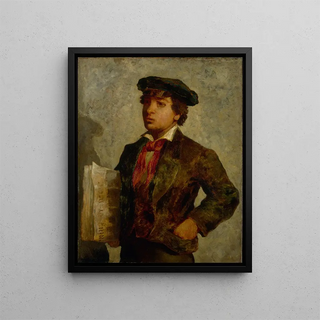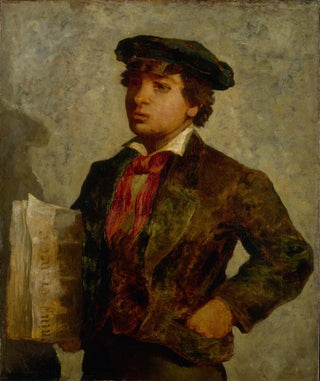Art print | Boy with newspapers - Edward Mitchell Bannister


View from behind

Frame (optional)
"Garçon de journaux" by Edward Mitchell Bannister stands as a poignant testament to daily life in the 19th century, while revealing the subtleties of the human condition through the lens of a young newspaper vendor. This piece, imbued with realism and emotion, captures a fleeting moment, a frozen instant where childhood innocence meets the harsh realities of urban life. Bannister, as an African-American artist, transcends the limitations of his era by offering a unique and personal vision of the challenges faced by young people from his community. The art print of this work allows you to immerse yourself in the vibrant universe of American art, while inspiring reflection on themes of innocence, aspiration, and struggle.
Style and uniqueness of the work
Bannister's style is distinguished by his bold use of color and light, which give his compositions an almost tangible atmosphere. In "Garçon de journaux," warm, earthy tones intertwine to create an ambiance that is both intimate and dynamic. The young boy's face, illuminated by soft light, expresses a multitude of emotions, ranging from hope to resignation. The chiaroscuro technique, mastered by the artist, enhances the contrasts between shadows and highlights, making the scene even more lively. Every detail, from the boy's determined gaze to the texture of his clothing, reflects meticulous attention that invites the viewer to immerse themselves in this painting. This striking realism, combined with a unique artistic sensitivity, makes this work a masterpiece that still resonates today.
The artist and his influence
Edward Mitchell Bannister, born in 1828, is an iconic figure in 19th-century American art. As an African-American artist, he had to navigate through a often hostile artistic landscape, but he managed to establish himself thanks to his undeniable talent and vision. Bannister was a pioneer in representing the daily life of African Americans, blending social themes with refined technique. His journey, marked

Matte finish

View from behind

Frame (optional)
"Garçon de journaux" by Edward Mitchell Bannister stands as a poignant testament to daily life in the 19th century, while revealing the subtleties of the human condition through the lens of a young newspaper vendor. This piece, imbued with realism and emotion, captures a fleeting moment, a frozen instant where childhood innocence meets the harsh realities of urban life. Bannister, as an African-American artist, transcends the limitations of his era by offering a unique and personal vision of the challenges faced by young people from his community. The art print of this work allows you to immerse yourself in the vibrant universe of American art, while inspiring reflection on themes of innocence, aspiration, and struggle.
Style and uniqueness of the work
Bannister's style is distinguished by his bold use of color and light, which give his compositions an almost tangible atmosphere. In "Garçon de journaux," warm, earthy tones intertwine to create an ambiance that is both intimate and dynamic. The young boy's face, illuminated by soft light, expresses a multitude of emotions, ranging from hope to resignation. The chiaroscuro technique, mastered by the artist, enhances the contrasts between shadows and highlights, making the scene even more lively. Every detail, from the boy's determined gaze to the texture of his clothing, reflects meticulous attention that invites the viewer to immerse themselves in this painting. This striking realism, combined with a unique artistic sensitivity, makes this work a masterpiece that still resonates today.
The artist and his influence
Edward Mitchell Bannister, born in 1828, is an iconic figure in 19th-century American art. As an African-American artist, he had to navigate through a often hostile artistic landscape, but he managed to establish himself thanks to his undeniable talent and vision. Bannister was a pioneer in representing the daily life of African Americans, blending social themes with refined technique. His journey, marked






